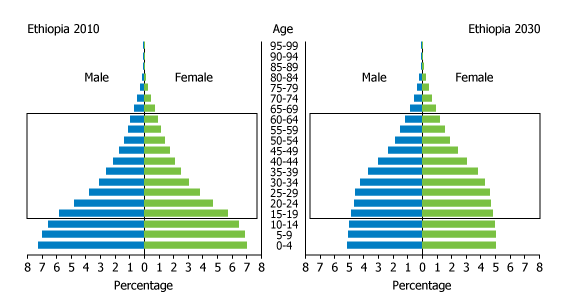
Ethiopia and the Demographic Dividend
Date
November 25, 2012
Author
(November 2012) Over the last decade, Ethiopia has made amazing progress in improving the health and development of its people. Infant and maternal mortality are on the decline, under-5 mortality has been cut in half, and literacy has nearly doubled.1 At the same time, women’s reproductive health has increased greatly, and many more women have the ability and decisionmaking power to plan their pregnancies, and are using modern methods of contraception. Among married women, use of modern contraceptive methods has grown from 6 percent in 2000 to 27 percent of married women today.2 Women are now having on average 4.8 children, compared with 6.5 a decade ago; and in Addis Ababa, the capital, women on average have just over two children.3
Recent economic growth has also been strong in Ethiopia, and based on the health and demographic changes occurring, one might expect Ethiopia to be poised to accelerate economic growth even further via a demographic dividend. A closer look at Ethiopia’s population projections and age-sex structure, however, reveals that Ethiopia will have to substantially increase its investments in meeting family planning needs to create the age structure needed for a demographic dividend. In Ethiopia today, more than 40 percent of the population is under age 15, and the population pyramid in 2010, despite the declines in mortality and fertility, is still dominated by a large base of young people (see pyramid for 2010).
Ethiopia’s Age and Sex Structure, 2010 and 2030

Note: Black boxes encompass working-age population.
Source: United Nations Population Division, World Population Prospects: The 2010 Revision, medium variant (New York: UNFPA, 2011).
Even if Ethiopia continues to make rapid progress to in meeting family planning needs and fertility declines by 2030 to women having on average 2.5 children, the country will just approach the age structure conditions that can facilitate accelerated economic growth (see pyramid for 2030). Thus, Ethiopia, one of several emerging success stories in terms of health and development, remains more than two decades away from a possible demographic dividend even with continued progress. For many neighboring countries that have made less progress in reducing mortality and fertility, a demographic dividend is even further away without substantial additional investments.
Jason Bremner is program director, Population, Health, and Environment, at the Population Reference Bureau.
References
- Ethiopia Demographic and Health Surveys, data from 2000, 2005, and 2011, accessed at www.statcompiler.com.
- Ethiopia Demographic and Health Surveys, data from 2000, 2005, and 2011, accessed at www.statcompiler.com.
- Ethiopia Central Statistical Agency and ICF International, Ethiopia Demographic and Health Survey 2011 (Calverton, MD: ICF International, 2012).
